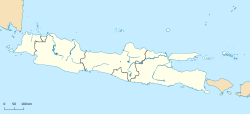Cepu, Blora
Cepu | |
|---|---|
 Solo River in Cepu district | |
| Coordinates: 7°9′S 111°35′E / 7.150°S 111.583°E | |
| Country | Indonesia |
| Province | Central Java |
| Regency | Blora |
| Capital | Cepu |
| Government | |
| Area | |
| • Total | 49.81 km2 (19.23 sq mi) |
| Population (2020 Census) | |
| • Total | 76,370 |
| • Density | 1,500/km2 (4,000/sq mi) |
| [1] | |
| Time zone | UTC+7 (WIB) |
| Area code | 0296 |
| Website | Official website |
Cepu (formerly Tjepoe or Tjepu) is a district (kecamatan) of Indonesia in Blora Regency, Central Java Province. Its seat is the town of Cepu.
History and economy[edit]
In colonial times, when Indonesia was part of the Dutch East Indies, Cepu was known for its teak (timber) and oil. The oil refineries, operated by Bataafse Petroleum Maatschappij, could produce about 11,000 bpd.[2] They were blown up by the Dutch immediately after the Japanese landings on the island of Java in 1942. The invaders, one of whose objectives was the oilfields, committed atrocities.[3][4] The teak is still highly regarded.[5] By 2001, the oil reserves were thought to have been exhausted; but new ones have been discovered by ExxonMobil, which may yield 235,000 bpd.[6][7][8]
Weather, climate and ecology[edit]
The nearest weather station to Cepu town appears to be Surakarta, Central Java, 104 km (65 mi) away.[9]
Language[edit]
The local language is Bahasa Jawa Blora, a dialect of Javanese.
Subdivisions[edit]
Cepu District comprises the following rural and urban villages:[citation needed]
Transportation[edit]
Cepu lies between Semarang (127 km (79 mi)), the capital of Central Java Province, and Surabaya (179 km (111 mi)), the capital of East Java Province, and is connected to them by road. It is 30 km (19 mi) from Blora, the capital of Blora Regency.[10]
Cepu is served by Cepu railway station and Ngloram Airport.
Cepu Forest Railway is a steam-powered narrow-gauge light logging railway that also runs tourist trains.
People[edit]
- Mukti Ali (1923-2004), Minister of Religious Affairs of the Republic of Indonesia; born in Cepu
- Sekarmadji Maridjan Kartosuwiryo (1905-1962), Indonesian Islamic mystic; born in Cepu
- Leonardus Benjamin Moerdani (1932-2004), general, Commander-in-Chief of ABRI 1983-1988, Minister of Defense and Security; born in Cepu

References[edit]
- ^ Badan Pusat Statistik, Jakarta, 2021.
- ^ McCabe, Richard Grant (1932). Petroleum Refineries in Foreign Countries, 1931. U.S. Government Printing Office. p. 28. Retrieved 4 October 2020.
- ^ "De oorzaak van geweld" (in Dutch). 24 October 2012. Retrieved 4 October 2020.
- ^ "Thrust at Tjepose: Invaders Seek Oil Supply". The Mercury. Hobart, Tasmania. 2 March 1942. p. 2. Retrieved 4 October 2020.
- ^ "The advantages of Teak wood in Central Java, East Java and West Java". tabudesign.asia. 1 May 2019. Retrieved 3 October 2020.
- ^ Sorkhabi, Rasoul (2009). "Cepu Block, Java". GEO ExPro. Vol. 6, no. 4. Retrieved 3 October 2020.
- ^ "ExxonMobil's Cepu block may produce 235,000 bpd, more than estimated capacity - regulator". Reuters. 8 August 2019. Retrieved 3 October 2020.
- ^ "Cepu block". ExxonMobil. Retrieved 5 October 2020.
- ^ "Climate in Cepu (Central Java), Indonesia". weather-and-climate.com. Retrieved 5 October 2020.
- ^ "Tjepoe: Indonesia". geographic.org. Retrieved 4 October 2020.
Further reading[edit]
- Imron, M. A.; Tantaryzard, M.; Satria, R. A.; Maulana, I.; Pudyatmoko, S. (July 2018). "Understory Avian Community in a Teak Forest of Cepu, Central Java". Journal of Tropical Forest Science. 30 (4): 509–518. doi:10.26525/jtfs2018.30.4.509518. JSTOR 26513038.
- Setiawan, A. (2019). The Socio-economic Impact of National and Foreign Oil Mining Companies Existences and Activities in Tjepu 1967-2004. IOP Conf. Series: Earth and Environmental Science. Vol. 325. p. 012011. Bibcode:2019E&ES..325a2011S. doi:10.1088/1755-1315/325/1/012011.


